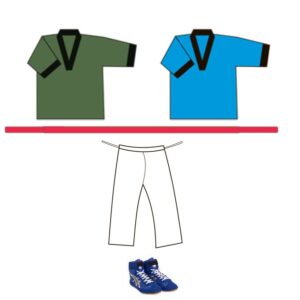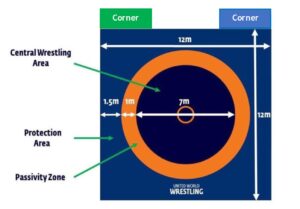Alysh rules in short
I. General definition
Alysh is national belt wrestling of the Kyrgyz people with the fixed capture for a belt. Both men and women take part in the struggle. In Alysh there is division in the freestyle (technical actions with feet are permitted) and classic style (technical actions with feet are prohibited).
Historical roots of “Alysh” belt wrestling go back into much further past. This kind of wrestling is considered to be one of the ancient sports games of Kyrgyz people.
Wrestlers wear special either a blue or a green jackets, white trousers and red belts. In starting point, the head of the wrestler is on the opponent’s scapulae, at the same time he/she follows the movements of the opponent’s legs under his/her arms. Wrestlers hold each other’s belt by bending forward in his own lap section of the belt and left hand over the opponent’s right hand. Wrestling is held only in standing position. The task of every wrestler is to try to pin the opponent down, by holding his/her belt.
Competitions on Alysh belt wrestling are held on UWW approved mat of 12х12 meters. The mat is divided into 4 parts:
– circle must be traced in the middle of the mat with an inside diameter of one meter and a surrounding band 10 cm wide;
– central surface of wrestling is inside part of the mat 7m of diameter;
– passivity zone – orange band of 1m wide;
– protection area 1.5 m in width.
III. Uniform
Competitor’s uniform consists of white pants, special sports shirts of green and blue color and red belt. The participant called on bout the first, puts on a green jacket, and the second participant – blue. The participants must wear wrestling shoes.
A belt shall be 150-180 cm in length and 4-7 cm in width. The uniform should be made of thick cotton.
IV. Competition system
Competitions take place by direct elimination system with an ideal number of wrestlers, i.e. 8, 16, 32, 64, etc. If there is no ideal number of wrestlers in a category, qualification matches will take place.
Wrestlers who win in the semifinals advance to finals, and losers automatically take 3 places.
The competition takes place in the following manner:
– Qualification rounds,
– Elimination rounds,
– Finals.
If there are less than 7 wrestlers in weight category, athletes are divided into 2 groups in which the Nordic system (circular) is used. In semifinals, first place of the first group faces second place of second group, and first place of the second group faces second place of the first group.
V. Weight categories
The weight categories for Alysh freestyle and classic style (men and women) are as follows:
- Seniors (20 years and older):
– men: 60 kg, 70 kg, 80 kg, 90 kg, 100 kg, +100 kg.
– women: 55 kg, 60 kg, 65 kg, 70 kg, 75 kg, +75 kg. - Juniors (18-19 years old):
– male juniors: 60, 65, 70, 80, 90, 100, +100 kg.
– female juniors: 50, 55, 60, 65, 70, 75, +75 kg. - Cadets U17 (16-17 years old)
– young boys: 45 kg, 50 kg, 55 kg, 60 kg, 65 kg, 70 kg, -75 kg, +75 kg.
– young girls: 40 kg, 45 kg, 50 kg, 55 kg, 60 kg, 65 kg, +65 kg. - Schoolchildren U15 (14-15 years old)
– boys: 50 kg, 55 kg, 60 kg, 65 kg, 70 kg.
– girls: 40 kg, 45 kg, 50 kg, 55 kg.
VI. Bout
In competitions among seniors (men and women) bout consists of 1 period of 3 minutes, among boys and girls – 2 minutes. Bout takes place only in standing position.
Refereeing body for each bout shall consist of mat chairman, referee and judge.
The referee, standing in the central circle in the middle of the mat, calls the two wrestlers to his side. Then he shakes hands with them and examines their dress, checks that they are not covered with any greasy or sticky substance, verifies that they are not perspiring and verifies that their hands are bare.
The wrestlers greet each other, shake hands and get into position and when the referee announces “ALYSH”, they start the bout. In any another cases, the referee blows his whistle.
When the bout has ended mat chairman announces winner and referee raises his hand. Then wrestlers shake hands and leave mat.
In classic style, it is strictly forbidden to grasp the opponent below the belt line, or to trip him or to use the legs actively on his opponent to perform any action in the standing position, with the exception of the use of leg, when the opponent is lifted in the air.
VII. End of the Bout
The bout ends either when a fall, a disqualification by injury of one of the opponents are declared, or at the end of the regular time.
A match ends by technical superiority (6 points of difference). The mat chairman signals the referee when the 6 points difference has been attained. The referee shall declare the winner after consulting with members of the officiating team for the match.
If the referee has not heard the gong, the mat chairman must intervene and stop the bout by throwing a soft object on the mat, in order to attract the referee’s attention. Any action begun at the time when the gong sounds is not validated and no action performed between the sounds of the gong and the referee’s whistle is valid.
When the bout has ended, the referee stands in the center of the mat facing the mat chairman’s table. The wrestlers lift one side of the belt to the shoulder and shake hands with the referee, stand on either side of the referee and await the decision. They are forbidden to take off their gear before leaving the competition hall. Immediately after the decision is announced, the wrestlers shake hands.
Then each wrestler must shake hands with his opponent’s coach. If the above provisions are not observed, the wrestler at fault will be penalized in accordance with the Disciplinary Regulations.
VIII. Types of victories
A bout may be won:
– by fall (“TAZA”),
– by injury,
– by 3 cautions given to the opponent during a bout,
– by technical superiority (6 points of difference),
– following a forfeit,
– by a disqualification,
– by points.
In case of tie by points at the end of the regular time, the winner will be declared by successively considering:
1. The highest valued action.
2. Lowest number of cautions.
3. Last wrestler to score.
The winner is declared by the addition of the points at the end of the regular time.
The fall stops automatically the match whatever the time.
The bout must be stopped before the end of regular time regardless of the score when there are 6 points of difference (technical superiority).
A wrestler receiving 3 cautions during a match loses the bout. 3rd caution must be given unanimously by the refereeing body.
IX. Values assigned to the actions and holds.
Pure victory (called “TAZA” and recorded in the Score Sheet as “5”) is awarded for:
– throwing an opponent on the back (scapula);
– counter-action, during which the opponent falls on his back.
Two points (recorded in the Score Sheet as “2”) are awarded for:
– in the case of an opponent’s throw to the side, in a danger position;
– if the attacker touches the mat first during the execution with one or both knees without stopping and the defender fall in a danger position;
– in the case of blocking an opponent on his side, in a danger position;
– for a roll on the side less than 90* (abdomen, pelvis).
One point (recorded in the Score Sheet as “1”) is awarded:
– for a roll on two knees.
No evaluation:
– If during the move by the attacking wrestler, he falls on his own back or rolls over the mat with his shoulder blades, and then the attacked wrestler falls without blocking him in danger position, then this technical action is not evaluated;
– TAZA in the protection area is not valid.
– if both wrestlers simultaneously fall on their sides in a neutral position, then this technical action is not evaluated.
Verbal warning (recorded in the Score Sheet as “V”):
– In the classic style a verbal warning is given to the wrestler who tries for the first time to make a technical action using his legs and/or feet, while they are on the mat with their feet.
Clarification for using the legs in the standing position in the classic style:It is allowed for the attacking athlete to use a leg, when the opponent is lifted in the air.
The opponent must first be lifted in the air and then the attacking athlete can use his leg to make an action (for example the technique “KAYTARMA” can be used when the opponent is in the air).
Caution (recorded in the Score Sheet as “O”) is given for:
– in the case of repeated passive action of the match;
– if the attacker repeatedly violates rules and breaks the hold during the action;
– in case of repeated actions escaping the mat;
– in the classic style if the attacker repeatedly makes a throw using his legs and/or feet (in the standing position on the mat).
After each caution (O) the opponent will automatically receive 1 point.
X. Prohibited actions
The following holds and actions are illegal and strictly prohibited:
– The wrestler is forbidden to disengage the hold during the entire time of the match.
– In case the wrestler stretches the grip and, without releasing the grip, lean against his fist in the side or in the iliac hollow of the opponent;
– In the case that the wrestler leans his head against the chest of the opponent;
– Passivity – It’s the inactive conduct of a match, which the athlete only trying to prevent technical actions of his opponent.





